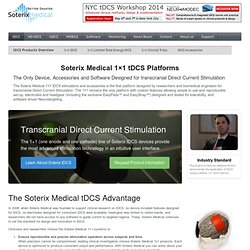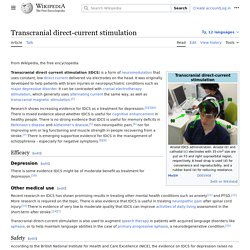

NeuroSky - Brainwave Sensors for Everybody. User-Built tDCS Research Device. I’ve been tinkering with tDCS for several months now – including doing lots of reading and building of prototype devices.

I also have a number of friends who are giving it a try. Along the way I’ve learned a number of things that could be useful to others: 1. Read, read, read. Lots of tDCS articles and dialog are on the web and more every day. 2. 3. 4. 5. tDCS devices built around the LM334 seem to work very well and provide very smooth adjustments to current level 6. In conjunction with the above, here is the schematic I use to build devices to tinker with. (This is my favorite design. (Almost done. (Completed except for labeling. (Digital meter in place of analog.) (Same basic design, just digital mA meter.) And finally, here is a link to a bit of doc I’ve written for use with the home-built tDCS research device and ActivaDose II. Comments and suggestions are welcome. Like this: Like Loading... Comparing the Fisher Wallace Stimulator with tDCS : Fisher Wallace Laboratories. Home. DIY tDCS. Soterix Medical.
Transcranial Direct Current Stimulation (tDCS) is a non-invasive procedure in which a device sends a small Direct Current (DC) across the scalp to modulate brain function.

The Soterix Medical 1x1 tDCS Low-Intensity Stimulator sends a low-level current from the positive electrode, anode, to the negative electrode, cathode. When the extremely low level current passes from the anode to the cathode, it may simultaneously increase the activity of the brain by the anode and decrease the activity of the brain near the cathode. tDCS mechanisms are considered to result from the ability of very weak DC currents to safely induce reversible changes in cortical plasticity. The induction of lasting changes in cortical excitability can, under some conditions, reversibly modify behavior and interact with normal learning. tDCS dose can be defined as: 1) The size and position of the electrodes on the body and 2) The duration (in minutes) and intensity (in mA) of current passed across the electrodes. Transcranial direct-current stimulation. Transcranial direct current stimulation (tDCS) is a form of neuromodulation that uses constant, low direct current delivered via electrodes on the head.

It can be contrasted with cranial electrotherapy stimulation, which generally uses alternating current the same way.[1] It was originally developed to help patients with brain injuries or psychiatric conditions like major depressive disorder. There is increasing evidence for tDCS as a treatment for depression.[2][3][4] However, there is mixed evidence about whether tDCS is useful for cognitive enhancement in healthy people. Several reviews have found evidence of small yet significant cognitive improvements.[5][6][7][8] Other reviews found no evidence at all,[9][10] although one of them[10] has been criticized for overlooking within-subject effects[11] and evidence from multiple-session tDCS trials.
Medical use[edit] Adverse effects and contraindications[edit] Mechanism of action[edit] Operation[edit] Parts[edit] Setup[edit] History[edit]